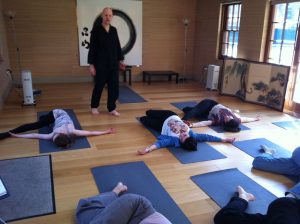 The number one complaint almost everyone has, at some point in their life, is low back pain.
The number one complaint almost everyone has, at some point in their life, is low back pain.
This is probably one of the most challenging topics that arise with clients and managing low back pain requires a willingness to think about the pain a little differently.
I learned this lesson myself 15 years ago when I violently ruptured a disc in my low back, resulting in a miserable ambulance ride to the hospital and a miserable couple of days not being able to walk without help.
After months of hard work, I was mostly recovered, with just some nerve pain down my left side to remind me to pay attention to my physical fitness. The nerve pain comes and goes depending upon my stress level and sometimes, if I’m not paying attention, will wake me in the middle of the night in agony.
 If I have been physically inactive for more than a day or two, the pain begins as discomfort then becomes louder until it transforms into a burning line from the outside of my left foot to the back of my hip.
If I have been physically inactive for more than a day or two, the pain begins as discomfort then becomes louder until it transforms into a burning line from the outside of my left foot to the back of my hip.
Once I pay attention and stretch, move more, manage my stress better, it abates within a few days.
My personal experience, and my experience with clients, made me realize long ago that chronic low back pain generally is not something that should be babied.
Medication is rarely helpful, surgery often makes the situation worse, MRIs provide misleading information and, when our back hurts, we should think about why it hurts, rather than telling it to “shut up!” with a few Vicodin.
The other day, while reading The New York Times, I noticed that the American College of Physicians (ACP) have released new guidelines for the treatment of low back pain that include urging doctors not to prescribe opioids such as Percocet, Vicodin and Demerol. Even things like anti-inflammatory medications such as Advil should not be the first line of defense.
 The ACP recommendations for low back pain and discomfort begin with, “superficial heat… massage, acupuncture, or spinal manipulation…”
The ACP recommendations for low back pain and discomfort begin with, “superficial heat… massage, acupuncture, or spinal manipulation…”
For managing chronic low back pain, their guidelines include things like tai chi, stress management, exercise, and different cognitive therapies to address the pain and the ways it affects your life.
I would add that restorative Pilates and yoga offer tremendous benefits to those with chronic pain of any type.
After reading the guidelines, I was clapping my hands with glee!
Finally, the medical community is waking up other ways to treat chronic conditions rather than throw pills at it.
The NYT article likened low back pain to the common cold—it just needs to “run its course.” Except, low back pain can take a lot longer to “run its course” than the common cold and often returns with more regularity.
The very best advice I received, and pass along to my clients, is — learn to be unafraid of the pain. This is often easier said than done.
 Rather, see the pain as your wake-up call, or your body’s way of communicating with you. There is a reason for the pain. Find the reason and deal with that, rather than the wake-up call. The medical community is figuring this out which is why things like yoga, tai chi and stress management are now part of the treatment for low back pain.
Rather, see the pain as your wake-up call, or your body’s way of communicating with you. There is a reason for the pain. Find the reason and deal with that, rather than the wake-up call. The medical community is figuring this out which is why things like yoga, tai chi and stress management are now part of the treatment for low back pain.
The next time your lower back is unhappy, rather than grabbing a pill, take a moment to consider what the pain is about. Lie on the floor and rest your legs on a footstool, ottoman or coffee table, so your knees are at about a 90-degree angle.
A small pillow under your head may help your neck to relax.
If you enjoy music have something soothing playing, and then take your awareness to each part of your body. Start with your toes and move upward as you release any tension you might be holding, while you breath in and out fully.
If you are unable to release the tension in a particular body part, often the neck or jaw, don’t fight yourself. Just notice the tension and move on.
 Once you are as relaxed as you can be, allow your thoughts to wander without holding on to any particular thought.
Once you are as relaxed as you can be, allow your thoughts to wander without holding on to any particular thought.
In this relaxed state, notice if things that cause you to feel stress begin to arise. Are you worried about money, a relationship, or a job? Notice where in your body the tension becomes greater when those stressful thoughts arise.
Then, each time you exhale, see if you can encourage your body back into relaxation. The most important part of this exercise is just noticing how your thoughts affect the tension in your body.
If you can begin to see that relationship between your body and your thoughts after 15 minutes of this practice, you are beginning your journey to successfully managing lower back pain!
I know this is easier said than done, but changing your relationship with your body is the way you recover from being controlled by pain.
Virginia Eaton is a health and fitness coach helping people reorganize priorities.



